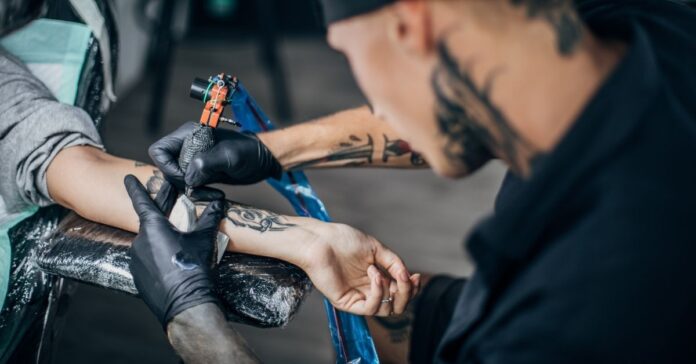The statistics show that close to 200 million Americans have tattoos, and when it comes to the population of the world, it is estimated that more than 20 percent of everyone on our planet has at least one tattoo. The popularity of these art pieces is growing continuously, and the practice has been popular since ancient times. In the past, tattoos had a different significance, and nowadays, we use this method to show off our style, creativity, and freedom, or to show respect to people that we cherish. If you have never gotten a piece before, you are probably worried about the pain that you are going to feel through the process, and here, we are going to help you learn what you can do to minimize it. Keep on reading to find out what is the most painful tattoo method and which parts of the body you should steer away from tattooing.
Most common techniques

The first thing we are going to talk about is the most common tattoo techniques that have been used in the past and that are used nowadays. As you probably know, depending on the area as well as the time in history, the methods of making a tattoo vary greatly, and some of these techniques are better or less painful than others. Before you go to tattoo saloon, you need to get familiar with the painful tattoo spots.
In some cultures, the journey to getting the tattoo was not as important as the final look of the piece, and in some places, the more painful the process is, the better the tattoo looks. Today, in modern societies, we are doing everything we can to make this process as painless as possible, and we try to make the client as comfortable as they can be.
Keep in mind that depending on the tools as well as the place of the body that is getting tattooed, once again, the pain will vary and there are spots where the client will not feel any pain, while there are also those parts of the body that are extremely sensitive, and no matter the technique, the client will still be uncomfortable.
The most common techniques include puncturing, piercing, and cutting the flesh. The first method uses tools that are used to puncture the skin, and for this process, the technician needs to apply force. Nowadays, that is most commonly done with a special tool or a tattoo machine that does all the work instead of the technician, and in some cultures, that is done manually and special tools are used to puncture the flesh and let the product enter the needed part of the flesh.

The piercing is the most frequently used method and a sharp object, most commonly a needed, is used to penetrate the skin. This technique is the easiest one to do, and it is most commonly the least painful one. The process is fast and easy, and even though after a while it can become uncomfortable, it is not as painful as the other three.
On websites such as www.lumbuy.com, you can see that in today’s world, there are a lot of specialized tattoo machines that are helping not only the artist but the client as well. With these modern tools, the whole process is done much faster, and with that, the chances of the skin getting too sensitive and the process being too painful, are greatly reduced.
The last one, the cutting process is a practice that is not used in most tattoo shops, and as the name suggests, during this technique, the flesh is being cut or scratched. The way this works is that the tool is submerged in ink before the process starts, and then, the professional will either cut the flesh or they will scrape it deep enough until the ink penetrates the needed layer of the skin. This is considered to be the most painful one since it requires wounding the flesh over and over again until the ink settles.
Keep in mind that all these things need to be done with the right tools, and even though we may be used to one type of equipment or the other, there are a lot of societies and cultures, where the technicians use the ancient tools to keep the practice going. In those cultures, we can witness the use of glass, stone, and even metal tools for all of these techniques.
Which body part should you choose?

Now that you know more about the methods and which one is the most painful, let’s see how the placing affects the level of pain or discomfort.
When it comes to the least painful places, they include the forearm as well as the upper outer thigh. You can also opt for the outer parts of your bicep and shoulders, and you can go with a tattoo on your upper and lower back, as well as your calves.
When it comes to the places that are going to be the most painful, and that is definitely not recommended for people who have never had a tattoo done before, they include the armpits, the ribcage, ankles, the elbows and kneecaps, neck, spine, and all the places where the bone is pretty close to the skin and that is not protected by a layer of muscle or fat. Keep in mind that the groin area along with your intimate parts is also going to bring you a lot of pain, and these places include the nipples as well as the breasts.
One thing that not many people are aware of is that there are other factors that will play a huge role in the process. It is said that your gender, as well as your age, will make a difference, and your weight will be a factor as well. Women are more likely to experience more pain, especially if they are in the time of the month before they get their period. Younger individuals are more likely to experience less discomfort and those with extremely low or high body fat levels tend to feel more pain than the others.
Before getting a tattoo, you should always do your research and you should opt for a professional salon that will do everything in its power to make this experience as pleasant as it can be. The bigger the piece is, and the more outlines it has, the more discomfort you are going to feel. Make sure you do all the preparations in time, keep yourself hydrated, and note that you should go to an artist that will go through the process with you and that will answer all of your questions promptly and transparently.






